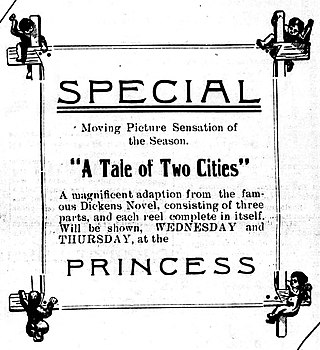Top Qs
Timeline
Chat
Perspective
A Tale of Two Cities (1911 film)
1911 film From Wikipedia, the free encyclopedia
Remove ads
A Tale of Two Cities is a 1911 silent film produced by Vitagraph Studios, loosely based on the 1859 novel by Charles Dickens.
Remove ads
Release and reception
Summarize
Perspective
The film's three reels were respectively released on February 21, 24, and 25, 1911.[1] Many film exhibitors at this time were hesitant to screen pictures of more than one reel, believing that audiences would not tolerate anything longer.[2] The Moving Picture World, however, called for all three reels of A Tale of Two Cities to be screened back-to-back,[3] which possibly inspired Vitagraph to issue its future multi-reel pictures as a single release.[4]
According to The Moving Picture World, the staging of the first reel "is little short of sumptuous. There is shown a care in the attention to details which stamps the picture as an unusually faithful reproduction and affords opportunity for those who have read and loved Dickens in the books to see his story move before them, much, perhaps, as it moved before him during its composition."[5] The magazine later listed A Tale of Two Cities among a group of films that adapted classic subjects, positing that these adaptations represented an upward trend of artistic quality in the film industry.[6]
The director Rex Ingram wrote in 1922: "In 1913, when I was studying drawings and sculpture at the Yale School of Fine Arts, a motion picture play, founded upon Charles Dickens' famous story A Tale of Two Cities, came to New Haven. It followed in the wake of many cut and dried one-reel subjects, and while this picture was necessarily full of imperfections, common to all pioneer films, it marked a tremendous step ahead in the making of them...I left the theatre greatly impressed; absolutely convinced that it would be through the medium of the film play, to the production of which the laws that govern the fine arts had been applied, that a universal understanding and appreciation of art finally would be reached."[7]
Due to the film's enormous success, Vitagraph reissued A Tale of Two Cities in 1913.[8]
Remove ads
Cast
- Maurice Costello as Sydney Carton
- Florence Turner as Lucie Manette
- John Bunny
- Norma Talmadge as The Seamstress[a]
- William J. Humphrey as The Duke D'Evremonde
- Florence Foley as The Woodcutter's Child
- Kenneth Casey as Duke's Son
- Ralph Ince
- James W. Morrison as Peasant Brother
- Julia Swayne Gordon
- Charles Kent as Dr. Manette
- Tefft Johnson
- Leo Delaney as Darnay
- William Shea as Jarvis Lorry
- Mabel Normand
- Earle Williams
- Edith Storey
- Lillian Walker as Peasant Sister
- Helen Gardner
- Dorothy Kelly
- Edwin R. Phillips
- Eleanor Radinoff
- Anita Stewart
- Lydia Yeamans Titus
Remove ads
Notes
- Talmadge's performance as the unnamed seamstress who accompanies Sydney Carton to the guillotine was the first role that brought her to public attention.[9] According to the early film historian Terry Ramsaye, A Tale of Two Cities is sometimes cited as Talmadge's first screen appearance due to the film's "forceful character", although she appeared in several earlier films such as The Household Pest and The First Violin.[10] For an extended account of her role, see Talmadge 1924, pp. 98–106.
References
Further reading
External links
Wikiwand - on
Seamless Wikipedia browsing. On steroids.
Remove ads

